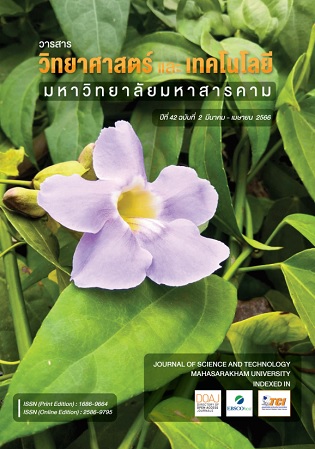ปัจจัยที่เหมาะสมในการชุบแข็งเหล็กกล้าคาร์บอน AISI 5106 ด้วยการออกแบบการทดลองแบบแฟกทอเรียล
Main Article Content
Abstract
The objective of this research is to determine the appropriate factors of hardening process for machetes, case studies of Ban Na Thon Thung community, Nakhon Phanom Province. The experiment is done by using the machetes that were made from the steel AISI5160. The temperatures in the experiments are at 750°C 800°C and 830 °C with holding time 2 and 5 minutes and quenched into oil and water. The results were analyzed and found that the best conditions for hardening machetes are at 764 °C with 5 minutes in oil.
Article Details
References
ณรงค์ศักดิ์ ธรรมโชต, สมบัติ น้อยมิ่ง, ศักดิ์สิทธ์ ศรีสุข, วรรณาหอมจะบก, อมรศักดิ์ มาใหญ่ และ จารุพงษ์บรรเทา. (2563). ปัจจัยที่เหมาะสมของอุณหภูมิและ เวลาการอบเพิ่มคาร์บอนที่มีต่อสมบัติเชิงกลของมีดโต้ที่ชุบแข็งในกระบวนการแพ็กคาร์เบอไรชิงโดยใช้กระดูกวัวเป็นสารเร่งปฏิกิริยา. Journal of Science & Technology MSU,39(3), 273-283.
สุภัทรวิทย์ ศรีนอก, ณรงค์ศักดิ์ ธรรมโชติ,จิตติวัฒน์ นิธิกาญจนธาร, รสรินทร์ ดือขุนทด, สมบัติ น้อยมิ่ง, ชัยวัฒน์ พีรทัตสุวรรณ และ อมรศักดิ์ มาใหญ่. (2559). การหาพารามิเตอร์ที่เหมาะสมในกระบวนการแพ็กคาร์เบอไรซิงโดยใช้สารเร่งปฏิกิริยาจากผงหินปูนสำาหรับการชุบแข็งมีดตัดอ้อย. การประชุมวิชาการข่ายงานวิศวกรรมอุตสาหการ ประจำาปี พ.ศ. 2559 ภาควิชาวิศวกรรมอุตสาหการ คณะวิศวกรรมศาสตร์ มหาวิทยาลัยขอนแก่น, (หน้า 1205-1210).
ลักขณา อินทร์บึง, อารดา ชัยเสนา, & รัชดา ภักดียิ่ง. (2020). ปัจจัยแห่งความสำาเร็จของกลุ่มวิสาหกิจชุมชนที่ได้ รับรองมาตรฐานผลิตภัณฑ์ชุมชน จังหวัดขอนแก่น. Journal of Roi Kaensarn Academi, 5(2), 1-12.
Apichai, P. (2020). Effects of quenchants on microstructures and mechanical properties of steel grade AISI 5160. Journal of Metals, Materials and Minerals, 30(3).
Bankole, M. T., Mohammed, I. A., Abdulkareem, A. S., Tijani, J. O., Ochigbo, S. S., Abubakre, O. K., & Afolabi, A. S. (2018). Optimization of supported bimetallic (Fe-Co/CaCO3) catalyst synthesis parameters for carbon nanotubes growth using factorial experimental design. Journal of Alloys and compounds, 749, 85-102.
Bitondo, C., Prisco, U., Squilace, A., Buonadonna, P., & Dionoro, G. (2011). Friction-stir welding of AA 2198 butt joints: mechanical characterization of the process and of the welds through DOE analysis. The International Journal of Advanced Manufacturing
Technology, 53(5), 505-516.
Han, X., Barber, G., Zhang, Z., Wang, B., Zhu, J., Shi, J., & Sun, X. (2018). Austenite-Bainite transformation kinetics in Austempered AISI 5160 Steel. European Scientif c Journal, 14.
Han, X., Zhang, Z., Hou, J., Barber, G. C., & Qiu, F. (2020). Tribological behavior of shot peened/austempered AISI 5160 steel. Tribology International,145, 106197.
Herbirowo, S., Hartadi, S., Widodo, R. D., & Adjiantoro, B. (2019). Optimization of mechanical strength and microstructure on Austempering zinc heat treatment in lateritic nickel steels Jurnal Sains Materi Indonesia, 20(4), 144-148.
Jaramillo, S., H. E., de Sánchez, N. A., & Avila D, J. A. (2019). Effect of the shot peening process on the fatigue strength of SAE 5160 steel. Proceedings of the Institution of Mechanical Engineers, Part C. Journal of Mechanical Engineering Science, 233(12), 4328-4335.
Lozano, D. E., Mercado-Solis, R. D., Colás, R., Canale, L. F., & Totten, G. E. (2012). Surface temperature and heat transfer coeff cient determination during quenching for martensite fraction prediction using a parabolic heat transfer model. In 6th Int. Quenching
and Control of Distortion Conf. (pp. 341-348).
MacKenzie, D. (2014). Selection of oil quenchants for heat treating processes. International Heat Treatment and Surface Engineering, 8(1), 8-14.
Penha, R. N., Canale, L. C., & Chiqueti, C. M. (2011). Influence of agitation rate on residual stresses and distortion on Quenched AISI 5160 Steel (No. 2011-36-0148). SAE Technical Paper.
Perla, S., Kulkarni, S., Balachandran, G., & Balasubramanian, V. (2017). Influence of section size and grain size on the microstructure evolution and mechanical properties in steel grade AISI 5160. Transactions of the Indian Institute of Metals, 70(9), 2449-2458.
Pimenta, C. D., Silva, M. B., de Morais Campos, R. L., & de Campos Junior, W. R. (2018). Desirability and design of experiments applied to the optimization of the reduction of decarburization of the process heat treatment for steel wire SAE 51B35. American Journal of Theoretical and Applied Statistics, 7(1), 35-44.
Ramos-Azpeitia, M., Ruiz-Ochoa, J. A., Hernandez-Rivera, J. L., & Perez-Alonso, C. A. (2021). Heat treatment optimization of CA-6NM cast alloy using a full factorial design of experiments approach. International Journal of Metalcasting, 15(1).
Richmire, S., Hall, K., & Haghshenas, M. (2018). Design of experiment study on hardness variations in friction stir welding of AM60 Mg alloy. Journal of Magnesium and Alloys, 6(3), 215-228.
Sathiya, P., Aravindan, S., Haq, A. N., & Paneerselvam, K. (2009). Optimization of friction welding parameters using evolutionary computational techniques. Journal of Materials Processing Technology, 209(5), 2576-2584.
Shinde, G. V., & Arakerimath, R. R. (2021). Multi-response optimization of friction stir welding process of dissimilar AA3003-H12 and C12200-H01 alloys using full factorial method. Proceedings of the Institution of Mechanical Engineers, Part E: Journal of Process Mechanical Engineering.Thant, K. K., Zaw, C. W. Y., & Zar, K. T. (2019, 31 August). Stresses analysis on spur gear for different contact ratio. European Aviation Safety Agency.
Zambrano, O. A., Gómez, J. A., Coronado, J. J., & Rodríguez, S. A. (2019). The sliding wear behavior of steels with the same hardness. Materials Science; Wear, 418, 201-207.


